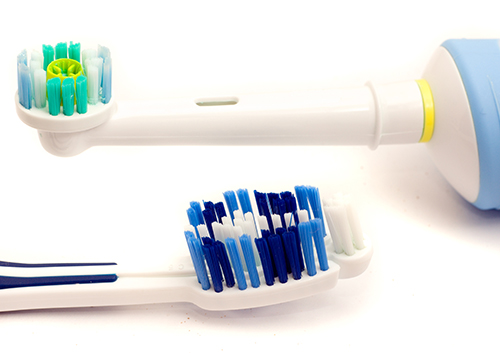Electric or Manual Toothbrush: Why It Does (and Doesn't) Matter
January 4th, 2018

You live in the golden age of toothbrushes. Until a few decades people used twigs or brushes made from animal hair to clean their teeth: not very soft and none too effective.
Now, you have a choice of manual brushes with soft, medium, or hard bristles. Or you might choose to go with an electric toothbrush instead.
Have you ever wondered whether manual or electric brushes provide better cleaning? Actually, they both do the job. The key is to brush and floss every day, regardless of the kind of brush you prefer.
At our Omaha office, we like to say the best brush is the one you'll use. So if you prefer manual, go for it. If you prefer electric, turn it on.
Both types have their advantages but both types will get the job done as far as removing plaque.
Electric Toothbrushes
- Provide power rotation that helps loosen plaque
- Are great for people with limited dexterity due to arthritis or other problems
- Are popular with kids who think the electric brushes are more fun to use
- Can come with variable speeds to help reduce pressure on sensitive teeth and gums
Manual Toothbrushes
- Can help brushers feel they have more control over the brushing process
- Allow brushers to respond to twinges and reduce the pressure applied to sensitive teeth and gums
- Are more convenient for packing when traveling
- Manual brushes are cheaper and easier to replace than the electric versions.
In many ways, the golden age is just beginning. There are already phone apps available to remind you to brush and floss. New apps can play two minutes worth of music while you brush, help you compare the brightness of your smile or help explain dental procedures. Maybe someday we’ll even have programs that examine your teeth after brushing and identify spots you might have missed.
Smile, the New Year is Almost Here!
December 26th, 2017

We’ve been celebrating the new year for a really, really long time. It goes way back, but it started formally in 1582, when Pope George XIII made January 1st the official holiday for ushering in the new year. The idea was to yell, cheer, and blow horns to scare away all the evil spirits of the previous year with the hope that the new one would be filled with happiness and opportunity.
While scaring away evil spirits isn’t what’s on our mind these days, we still ring in the New Year by cheering and hollering with friends and family. It’s a time to set new goals, refocus on old ones, and look forward to all the surprises the coming year will bring.
Whether you’re saying hello to the New Year snuggled up at home on your couch in the Omaha area or by gathering your friends for a social celebration, here are some tips to help ensure you welcome this new chapter with a smile.
Tips for a great New Year’s Eve celebration from R. William Barnard Orthodontics
- Stay safe. This one’s vital, because nothing puts a damper on your party like an emergency trip to the hospital. Stay responsible and try to plan ahead, whether that means taking a taxi, staying with a friend, or recruiting a designated driver. Do what you have to do to keep yourself and everyone around you safe.
- Spend time with the people you love most. The way we see it, the whole point of the holiday season is to cherish your family and friends. Regardless of what you’re doing, make sure there’s something for everyone. It’s essential to do something the whole group will enjoy!
- Smile! Whether you get all dressed to go out or have a quiet gathering with family and friends, make sure you accessorize with a smile. There’s always something to smile about!
We can all agree that change can be scary sometimes, but ringing in the New Year is an observance we all welcome with open arms. We hope you’ll enjoy this transitional holiday in a fun, healthy, and safe way. You have endless possibilities ahead of you!
From Dr. R. William Barnard and Dr. Nia Jones, have a fantastic New Year!
How a High-Tech Office Helps Your Orthodontic Treatment
December 19th, 2017

Our office strives to bring you the latest and greatest in orthodontic techniques and technologies. Being on the cutting edge of the industry is important—it ensures you, as our patient, are getting the best orthodontic treatment you possibly can while keeping costs down!
The goal of a high-tech office is three fold: to have effective treatment, to have efficient treatment, and to make the whole process easy, painless, and cost-effective for you.
Here are some of the technologies being implemented by Dr. R. William Barnard and Dr. Nia Jones to do just that:
3D oral scanners: If you've ever experienced getting impressions the traditional way, it isn't very fun! Having a gag reflex is common and it takes several minutes on both the top and bottom of the mouth to get a successful impression.
With 3D oral scanners, we create a perfect digital scan of your teeth without radiation. We then use the results of the scan to create accurate braces, retainers, and other appliances for your unique teeth and mouth.
Digital Imaging: New digital imaging provides us with accurate, panoramic, and cephalometric views of your teeth and their supporting structures. This lets us plan and implement treatment with the utmost precision.
Not only does this kind of imaging expose patients to far less radiation than traditional X-rays but it also gives us immediate access to the images, whereas X-rays had to be developed. This expedites treatment time and means fewer trips to our Omaha office for you.
New, high-tech braces options: There are so many more choices when it comes to braces these days! Advances in the industry like Invisalign®, self-ligating braces, and lingual braces, allow patients to not only get highly accurate and precise treatment, but do so discreetly without anyone else even knowing.
Digital scanning and imaging takes the guesswork out of braces. Instead of the orthodontist estimating tooth movement and treatment progression, these days it's all computer modeled with exacting detail. The result? Your braces do exactly what they're intended to do in less time with a picture-perfect outcome.
These are just some of the advances in the orthodontic industry. Needless to say, they all make the entire process that much easier and effective for you. If you have any questions or are interested in treatment, please don't hesitate to contact our Omaha office!
Periodontics and Braces Treatment
December 12th, 2017

Most people think braces are all about their teeth. While it is true orthodontics is meant to move your teeth into proper position, there's more to it than that. To safely move your teeth with braces, you're going to need healthy and stable gums (or periodontium—the tissues that support your teeth).
For this reason it's critical to have your periodontal health evaluated prior to getting braces. This applies particularly to adults, since a 2013 study by the Center For Disease Control found that an estimated 47.2% of adults 30 years of age and older had periodontitis (gum disease). If you do have periodontitis, moving your teeth with braces will only make things worse.
Conversely, there is also risk for periodontal disease if you don't get orthodontic treatment. Malocclusion, as well as crooked and spaced teeth, can all contribute to periodontal disease. In these situations your teeth and gums are more difficult to clean and become breeding grounds for disease causing bacteria. Bad oral hygiene combined with these traits can greatly contribute to the development of periodontitis.
So, periodontics and braces have a tricky relationship. On one hand, you shouldn't get braces if you show signs of developing or have periodontitis, while on the other hand, braces can help prevent the possibility of developing periodontitis by correcting the bite and straightening the teeth.
If you are 30 years of age or older and are considering getting braces, it would be wise to first:
- Let Dr. R. William Barnard and Dr. Nia Jones know about your desire to get braces
- Get an exam to make sure you're in good periodontal health and a good candidate for braces
- If you are a good candidate, keep an eye on your teeth and gums and get regular dental checkups throughout your entire course of treatment.
If you are in any doubt about the status of your teeth and gums, it's always best to get them checked before embarking with braces treatment. For more information or to have your periodontal health assessed for braces treatment, please contact our Omaha office.










